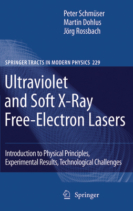by Peter Schmüser, Martin Dohlus and Jörg Rossbach, Springer. Hardback ISBN 9783540795711, £126 (€139.95, $189).

Even at first glance my impression of this book was positive. Many coloured illustrations with detailed comments attracted my attention, so initially I began to read around them. A further study did not alter this first impression.
The field of free-electron laser (FEL) technology has reached a high state of the art in recent years, with operation demonstrated at high power (14 kW at Jefferson Lab), for soft X-rays (FLASH at DESY) and hard X-rays (the Linac Coherent Light Source at SLAC). The authors are well known experts in the field. Jörg Rossbach, for example, led the successful development of FELs at DESY for many years. Therefore, their book is interesting not only as a primer on FEL physics for students, but also as a reflection of the “view from inside”, expressing the personal opinions of people who made a real FEL with unique radiation parameters.
“We must study a lot to learn something.” This three-century-old aphorism of the Baron de Montesquieu is fully true for modern technology, and in particular for FEL technology. One really needs to know much to understand how an FEL works, and much more to design and build an FEL facility. The book therefore covers both the theoretical description of FEL physics and the experimental methods used to build an FEL and to control the radiation parameters.
The first half provides an introduction to the theory of the FEL. It gives the reader a clear picture of electron motion in an FEL, with the 1-D FEL equations used to demonstrate principles of FEL operation. Analytical and numerical solutions of these equations, combined with a discussion of limitations of the 1-D theory, give the full and explicit picture of FEL physics. Despite the use of simplified mathematical models, the authors succeed in presenting a physically transparent description of issues as advanced as self-amplified spontaneous emission (SASE), the FEL radiation spectrum, radiation-energy fluctuations etc. Parametrizations of numerical results allow the reader to make fast but reasonable estimates of the influence of the electron-beam parameters on the length and output power of a SASE FEL. Some theoretical issues, which are frequently not included in courses on general physics, but are useful for deeper understanding, are briefly described with references to more detailed textbooks and are given in several appendices.
The second part of the book contains a description of experimental results and the FEL installation at the FLASH facility, which provides an excellent example for the explanation of technical details. It is recent enough to use relatively new techniques and approaches, but has operated long enough as a user facility for the experimental techniques to be well developed and tested, as well as for the real parameters of the electron and radiation beams and the corresponding limitations to be explored. The authors compare measurements with theoretical predictions for the dependence of the radiation power and the degree of bunching on the co-ordinate along the undulator, for example. This confirms that the numerous formulae of the first part are really useful.
The main part of the description of FLASH is devoted to the accelerator and electron-beam parameters. This is natural, because the cost of the accelerator and the efforts for its operation are the dominant parts of the cost and effort of the whole FEL installation. The undulator line, which is another important part of the FEL, is described only briefly, probably indicating that the FLASH undulator is so good and reliable that people almost forget about it. A brief discussion of the challenges and prospects for X-ray FELs concludes the book.
Because the book focuses on X-ray FELs, it cannot touch all aspects of FEL physics and technology, so some important FEL-related issues must be studied through other books and papers. For undulators the authors refer to the corresponding book by J A Clarke, The Science and Technology of Undulators and Wigglers (OUP 2004). A better understanding of high-gain FEL physics can be achieved by reading old books on microwave travelling-wave tubes, which contain almost all the equations and results of 1-D FEL theory. Indeed, the first high-gain FEL – the travelling-wave tube with undulator called the “ubitron” (150 kW peak power at 5 mm wavelength) – was built by Robert M Phillips in 1957. Further study may be continued through the annual FEL conference proceedings and references to papers they contain.
Thus, this book is very useful for students who are beginning to study FEL physics. It is also valuable for experts, who may look at their research from a different point of view and compare the authors’ way of presenting material with their own way of explaining FEL physics.





